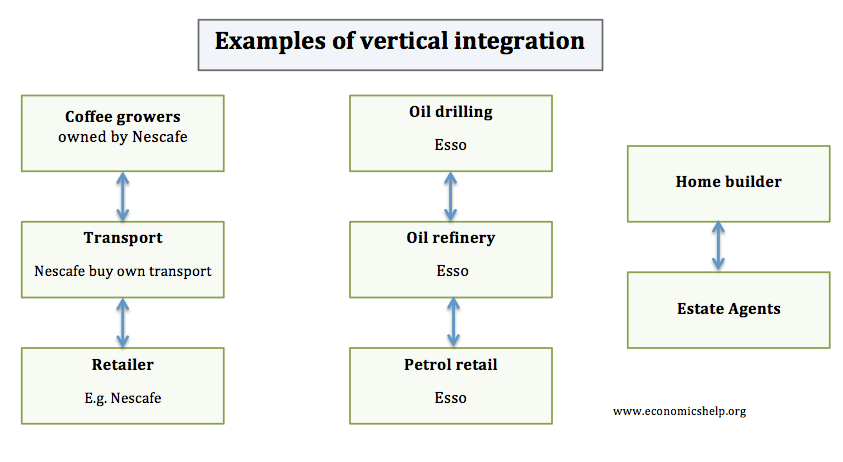Vertical integration occurs when a firm controls different stages of production.
For example, in the brewing industry, you have
- Production – Brewing of beer.
- Distribution – beer transported to local markets.
- Retail – Beer sold in pubs and shops.
- To remember vertical integration – think of going up the supply chain.
- Horizontal integration, by contrast, is at the same stage of production think of other business at the same stage of production, e.g. different pub companies, different brewers.
A large brewer could also own transport and the pub in which it is sold. In this case, the brewer has vertical integration. When a brewer owns a pub, it is known as a ‘tied pub’.
A ‘free pub’ occurs when the pub is not owned by a brewer but is free to sell whatever beers it wants to. In other words in a free pub, the ownership of retail is different to the ownership of production.
Backward Vertical Integration
Backward integration is when a firm buys a company who previously supplied raw materials to the firm. It is a type of vertical integration but specifically refers to the merging with firms who used to supply the firm.
Example of Backward integration
- A car firm buys the company who used to sell its tyres for its cars
- A coffee retailer like Nescafe mergers with coffee growers thereby controlling the supply of coffee beans
Backward integration may be beneficial if it helps secure a reliable source of supplies. It will be harmful if it leads to increased monopoly power and new competitors have difficulty accessing raw materials.
Forward Integration
This occurs when a firm merges with another firm at the next stage of production. For example, a company producing coffee beans could buy a chain of coffee shops. e.g. if Nescafe produces coffee beans, they could buy more coffee shops to sell their own beans in.
Pros of Vertical integration
- Economies of scale. A firm can benefit from economies of scale. E.g. organisational economies, financial economies of scale.
- Greater control over supply. A retailer can’t be affected by a supplier withholding supplies at various times.
- Overcome Monopsony power. A farmer may lose out to big supermarkets. However, if they become part of the supermarket chain they can benefit from their profitability.
- In the case of pubs, vertical integration gives a landlord greater resources because the big brewer can help them advertise and secure supplies at lower cost.
Cons of Vertical Integration
- Limited scope for technical economies of scale. Unlike horizontal integration, the firms who are merging will not be able to benefit from technical economies of scale because they don’t share the same production process
- More monopoly power which could lead to higher prices for consumers
- Lower prices to suppliers. Nescafe has been criticised for paying a low price to consumers. By controlling the purchase of raw materials farmers could be worse off.
- Less choice for consumers. Tied pubs only sell the beer from the brewery; this is an example of how consumers gain less choice of beer.


Economies of large scale operation and extended market reach is the advantages of both vertical and horizontal integration.
Material is very useful, for students of economics(MACRO)
thanks
Merger and Acquisition is to reduce effects of inflation and increased national product through reduced cost of production at a moderate price to all end customers.